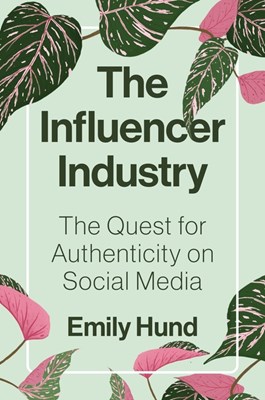The Influencer Industry: The Quest for Authenticity on Social Media
February 16, 2023
The Influencer Industry offers an excellent account of how young creatives turned the internet from a collection of decentralized pages to a highly interconnected, multi-billion-dollar enterprise.
 The Influencer Industry: The Quest for Authenticity on Social Media by Emily Hund, Princeton University Press
The Influencer Industry: The Quest for Authenticity on Social Media by Emily Hund, Princeton University Press
My career in social media began in 2015, when my boss at my first job out of college popped her head out of the office to call out “Hey, you’re a millennial—you know Facebook, right? Want to run the company account?” By then, I’d had an online presence for at least a decade already, bouncing from AOL Instant Messenger to MySpace to, yes, Facebook. I had no worries about running an organizational account, then. It was all just the same internet, after all; how hard could it be? And for many years, being a social media manager was just as fun and easy as I thought it would be. It gave me a space to be creative during my workday as I experimented with copywriting, photography, and graphic design, and I took pride in my role as a community builder for our online followers. It felt like the best job in the world—until it didn't.
Today, any digital marketer who's been doing this for years can tell you how radically the landscape has changed. In 2022, the New York Times ran a profile of small business owners whose visibility on Instagram plummeted after the platform began to prioritize videos over still images with thoughtful captions, demanding an entirely different skill set for dedicated users to find continued success. Organic content is effectively obsolete. Managing a company’s online presence has evolved to require scheduling software that tells you the optimal times to post online, the acquisition of new skills such as video and audio editing, and unwavering tenacity before the Sisyphean task of trying to understand and cater to each platform’s mysterious algorithm. Spaces that once felt like communities now feel like endless streams of optimized advertisements. How did we get to this place, and where are we supposed to go from here?
For all the time I’ve spent online, both in personal and professional capacities, I’ve realized how little I truly know about how the internet came to be this way. Emily Hund’s new book, The Influencer Industry, offers an excellent account of how young creatives turned the internet from a collection of decentralized pages to a highly interconnected, multi-billion-dollar enterprise. The Influencer Industry is just under 200 pages long yet is rich with research and stories from real influencers that shine a light on just how massive an industry “influencing” has become and how it has shaped the internet for everyone who is on it. Hund deftly analyzes the political, cultural, and societal implications of what it means to operate in a space that demands we all function as brands and where the definition of authenticity is forever shifting.
Hund, a researcher at the Center on Digital Culture and Society at the University of Pennsylvania, begins the book with the story of her own experience as a college graduate in 2009 trying to land a magazine job. The United States economy was still reeling from the 2008 global financial crisis, and unemployment was rampant across industries, including traditional media. While she worked in an unpaid internship at a notable fashion magazine and struggled to find a paying job, the same company was instead hiring bloggers whose personality-driven content was in higher demand. She wanted to understand what this “world-shifting pattern of events” meant for her own prospects and for society at large.
Hund argues that this time of economic precarity, paired with the advent of user-friendly blogging platforms and social media sites, spurred the creation of the contemporary influencer industry.
For many under- or unemployed people, particularly aspiring creative professionals, the internet and its many budding social media platforms seemed to offer a chance to move forward in a time marked by inertia and uncertainty […] Many people used blogs and platforms like Twitter, tumblr, and Facebook to communicate their professional expertise and personal interests with the hope of building reputations and attracting employers.
These early bloggers presented a fresh alternative to traditional media outlets while building out their own public portfolio—their conversational tone and genuine passion for interests such as fashion, beauty, and pop culture appealed to other internet users seeking a like-minded community.
This rise of internet personalities intersected with the need from traditional advertisers to find new, more effective ways of marketing to their jaded “buying public.” By partnering with bloggers and social media personalities, advertisers could filter their products through the voice of an actual person with established relationships. In return, these influencers—overwhelmingly women—found flexible, well-paying, and creatively fulfilling work in an otherwise difficult economic environment. The two industries of advertising and social influencing thus became inextricably intertwined.
Hund notes that by 2015—the same year I started managing a company social media presence—Google claimed that the search term “influencer marketing” was “experiencing growth greater than 5000 percent.” But as the industry swelled in size, the barriers to entry also increased. Hund writes:
To get by in the influencer industry’s new processes for identification, selection, and pricing, influencers needed to present themselves in more consistent, polished, and predictable ways—to more fully transmute the personal of their brands into language and aesthetics that were kin to those used by sponsors and marketers.
Standing out in a rapidly expanding field and successfully monetizing one’s social presence took on new requirements, from understanding traditional media metrics to testing and tweaking content to make it appealing to a broader audience, often at the cost of the influencer’s originality. Once-independent creators were now surrounding themselves with teams—photographers, stylists, writers, analysts, et cetera—to optimize their content. Eventually, the industry reached a breaking point:
Many influencers I interviewed in the late 2010s and early 2020s expressed similar frustrations with what they felt were continually increasing personal demands of working on social media, including heightened visibility and personal sharing, concern over blowback or hostilities from followers, and diminishing returns on their labor.
Those of us who have spent working hours on the internet are now at this crossroads: do we continue putting effort into this work, or do we leave? And for that matter, can we even leave? In my role as a professional social media manager, the returns on the investment of my time and creativity that have gone into maintaining company presences online are virtually nil these days—the types of posts that would have easily received hundreds of likes in the past are now lucky to get a dozen. It’s as if I have nothing to show for the years I’ve been in this line of work, and being able to stand out in the vastness of the internet—whether as myself or as any company I work for—has felt insurmountable. In the latter half of the book, Hund highlights influencers who have turned away from the platforms that once made them famous and instead opted to reclaim their creative identities by launching their own websites and podcasts, or in the case of influencers such as Essena O’Neill, withdrawing their public persona from the internet entirely.
Hund recognizes that the state of the internet affects—and is equally affected by—what goes on in government, media, the retail economy, et cetera. As long as the internet is around, we won't really be able to escape it. Bleak as this reality sounds, Hund offers a hopeful note:
Here I am inspired by the work of artist and author Jenny Odell, who has argued for a form of realistic resistance by increasing our awareness of where we direct our attention, why, and to what ends. Following Odell, my hope is for people to cultivate, as best they can, a mindset of distance and utility—to make our use of social media intentional, however serious or silly the intention may be.
I had already decided, entering this new year, that I would be gradually stepping away from my role as a social media manager—here at Porchlight, specifically, but also as a career overall, hopefully forever—to focus on other, more mentally nourishing projects, like writing more book reviews. The Influencer Industry validated my choice by helping me understand just how unwinnable of a game the internet has become—there's no real reward for trying to beat it.
But I’m also coming away with this: the contemporary influencer industry stemmed from a time when the status quo no longer served the people within it and the situation at hand felt dire. They responded to this with creativity and innovation, and for a time, they created a space where they could flourish and revel in their humanity. This is a good thing. I don’t think, then, that we’ll all be trapped in this ad-laden internet hellscape forever—if we can turn our attention once again to the creativity inside us, we may yet find something better waiting for us all.



